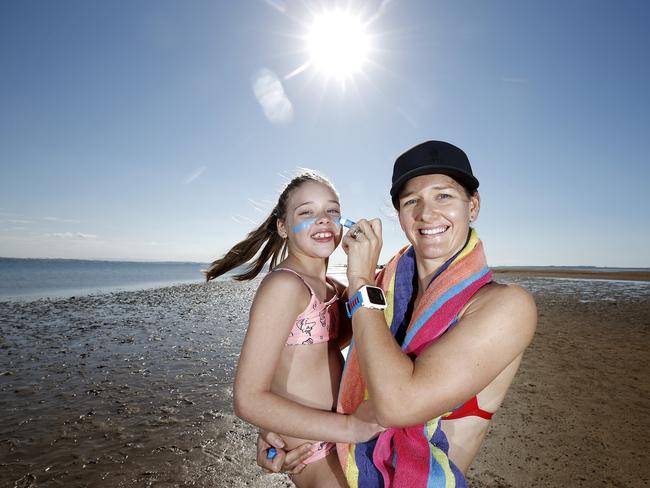Sun safety: Sunscreen not doing the job as heatwave deaths loom
LIFE might be great in the Sunshine State, but two recent revelations threaten to spoil our fun in the sun.
QLD News
Don't miss out on the headlines from QLD News. Followed categories will be added to My News.
SUNSCREEN that is SPF50 offers only marginally better protection than SPF30+, the Cancer Council Queensland has warned.
The misconception that there is almost double the block from the higher sun protection factor is putting Queenslanders at risk.
The revelation came amid warnings of an increase in heatwave-related deaths in the years ahead.
National policy on sunscreen use
New research published in journal Acta Dermato-Venereology shows that sunscreen users receive only half the protection they think they are getting.
“There is no dispute that sunscreen provides important protection against the cancer causing impact of the sun’s ultraviolet rays,” study author Professor Antony Young from King’s College, London said.
“However, what this research shows is the way sunscreen is applied plays an important role in determining how effective it is.
“It’s better for people to use a much higher SPF than they think is necessary.”
The CCQ says that at least one teaspoon of cream should be applied to each limb, front and back of the torso and face, including neck and ears.
This is equivalent to a full body application of at least 35ml, or seven teaspoons.
“A uniform coverage of sunscreen at a greater thickness, applied to clean, dry skin 20 minutes before you go outside will offer the best protection,” a spokeswoman for the CCQ said.
“Then reapply sunscreen every two hours and after swimming, exercising, or towel drying.
“The sun’s UV radiation is the major cause of skin cancer and can cause damage when the UV index is three or above, which is all year around in Queensland,” she said.
“The best defence against skin damage is to use multiple methods of protection.
“In addition to wearing sunscreen, we recommend wearing a hat, sunglasses and protective clothing when outdoors, and finding shade where possible.”

Meanwhile, the future looks bleak for the children of Queensland’s children, with scientists predicting a spike in heatwave deaths of up to 525 per cent.
The shock forecast compares deaths between 1971 to 2020 and 2031 to 2080 across the globe, including the Australian cities of Brisbane, Sydney and Melbourne.
The Monash-led study out today WED comes as the UK sizzles over summer forcing Public Health England to issue a heatwave warning.
Study lead author Monash Associate Professor Yuming Guo said the recent media reports detailing deadly heatwaves around the world highlight the importance of the heatwave study.
“Future heatwaves will be more frequent, more intense and will last much longer,” Associate Professor Guo said.
“If we cannot find a way to mitigate the climate change and help people adapt to heatwaves, there will be a big increase of heatwave-related deaths in the future, particularly in the poor countries located around the equator,” he said.
While Brisbane is forecast for a 400 to 525 per cent rise in heatwave related deaths some countries at the equator are looking at a rise of over 775 per cent.
Heatwaves can cause heat oedema, heat syncope, heatstroke, acute cerebrovascular incidents and can aggravate chronic pulmonary conditions, cardiac and kidney conditions and psychiatric illness.
The report, published in PLOS Medicine, aims to help decision makers in planning adaptation and mitigation strategies for climate change.
The reports shows that between 1988 and 2009 1,177,950 Australians died due to extreme heat.
“If the Australian government cannot put effort into reducing the impacts of heatwaves, more people will die because of heatwaves in the future,” Associate Professor Guo said.
The collective death toll across India, Greece, Japan and Canada continues to rise as the regions swelter through record temperatures, humidity, and wildfires.
Associate Professor Antonio Gasparrini, from the London School of Hygiene and Tropical Medicine and study co-author said since the turn of the century it’s thought heatwaves have been responsible for tens of thousands of deaths, including regions of Europe and Russia.
“The good news is that if we mitigate greenhouse gas emissions under scenarios that comply with the Paris Agreement, then the projected impact will be much reduced,” he said.


